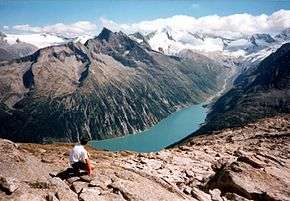Tyrol
Tyrol (German: Tirol) is a multi-national historical region in the heart of the Alps. It consists of North, East and South Tyrol. North and East Tyrol lie in Austria and together make up the Austrian federal-state of Tyrol with its capital in Innsbruck.
South Tyrol, despite its German-speaking majority, has been part of Italy since the end of World War I. It makes up the northern portion of the alpine Italian autonomous province Trentino-Alto Adige with its capital in Bolzano (Italian) or Bozen (German).
Regions
| North Tyrol (Innsbruck, Igls, Alpbach, Fieberbrunn, Hall in Tirol, Kufstein, Wattens, Mayrhofen, Reutte, Schwaz, St. Anton, St. Johann in Tirol, Eng, Paznaun Valley, Stanzer Valley) The northern part of Tyrol. It borders the German state of Bavaria to the north, Vorarlberg to the west, the Swiss canton Graubünden to the south-west, Salzburg to the east. |
| East Tyrol (Lienz, Kals, Hohe Tauern National Park) The eastern exclave of Austrian Tyrol, separated from the northern part by a strip of Salzburg and Italy. |
| Paznaun Valley An alpine valley on the Swiss border |
Cities
North Tyrol
Other destinations
Understand

Like its sister provinces of Bavaria in Germany and Salzburgerland in Austria, Tyrol is the very definition of the Germanic Alpine stereotype. Full of romantic lakes and castles and beer-drinking lederhosen-clad locals playing oom-pa-pa music and marching in bands, the place can seem a bit of a fairy tale to the visitor at times. Innsbruck and Bolzano/Bozen are the only real "bigger" cities, with the rest a beautiful natural panorama. The roads get clogged with tourists in the summer and winter months. South Tyrol sits on the sunny side of the Alps and is an interesting mix of three cultures.
Talk
As in nearly all of Austria, Austro-Bavarian is the main everyday spoken language of Tyrol (except in Reutte district where it is Alemannic). The Tyrolean dialect is even often tricky to understand for residents of eastern Austria (including Vienna) let alone from northern Germany. But, as in all of Austria, standard (Austrian) German is the official language used in all official publications and schools, so the vast majority speaks it, and in Innsbruck basically everyone is fluent. English is spoken by most educated middle aged and young people, and Italian is also quite prevalent due to the proximity of the South Tyrolian border and a small immigrant community in Innsbruck.
Get in
By plane
The main entry point by air is the 🌍 Innsbruck International Airport (INN IATA) which has schedules to Vienna, Frankfurt, London, Amsterdam, Graz, Nice, Hannover, Stavanger, Alghero, Gothenburg and Olbia. EasyJet also offers weekly low cost direct flights from Bristol on Fridays. Schedules may differ in winter.
The 🌍 Munich Airport (MUC IATA), 2.5 hours away by road transport, is another alternative. There are vans that will meet you at the Munich Airport and take you directly to your lodging in or around Innsbruck for the price of a comparable train ticket.
The 🌍 airfield of St. Johann in Tirol has a 750 m asphalt runway but no scheduled services.
By train
Considering the topography rail connections are impressive and a highly scenic and relaxing way to see the Tyrol. Trains also connect the "three Tyrols" via rail and tunnels.
Innsbruck has connections to all major cities in Austria such as Vienna, Graz, Salzburg, Linz and Bregenz.
Between Munich and Innsbruck, there is usually one train per hour with stops at Kufstein, Wörgl and Jenbach and trip times between 2:20 and 2:50.
By ski

Skiing into Tyrol is very easy from Switzerland when crossing the Silvretta above Samnaun. The mountain ridge is the border between Switzerland and Austria, and multiple lifts take skiers to the ridge from either side. Descending the mountain on one side leads back to Switzerland, the other side leads into Tyrol. There is no border checkpoint for obvious practical reasons, but skiers with a keen eye for detail may notice a ceremonial border guard who "patrols" the border on skis!
Get around
See

Do
- 🌍 Achenseebahn (Achensee Railway), Jenbach, Tyrol (Near Jenbach train station). Ride Europe's oldest steam-operated cog railway which opened in 1889.
Buy
Eat
- Tiroler Speck - a juniper-flavored ham
Drink
Sleep
Go next
- Bolzano/Bozen — capital of South Tyrol